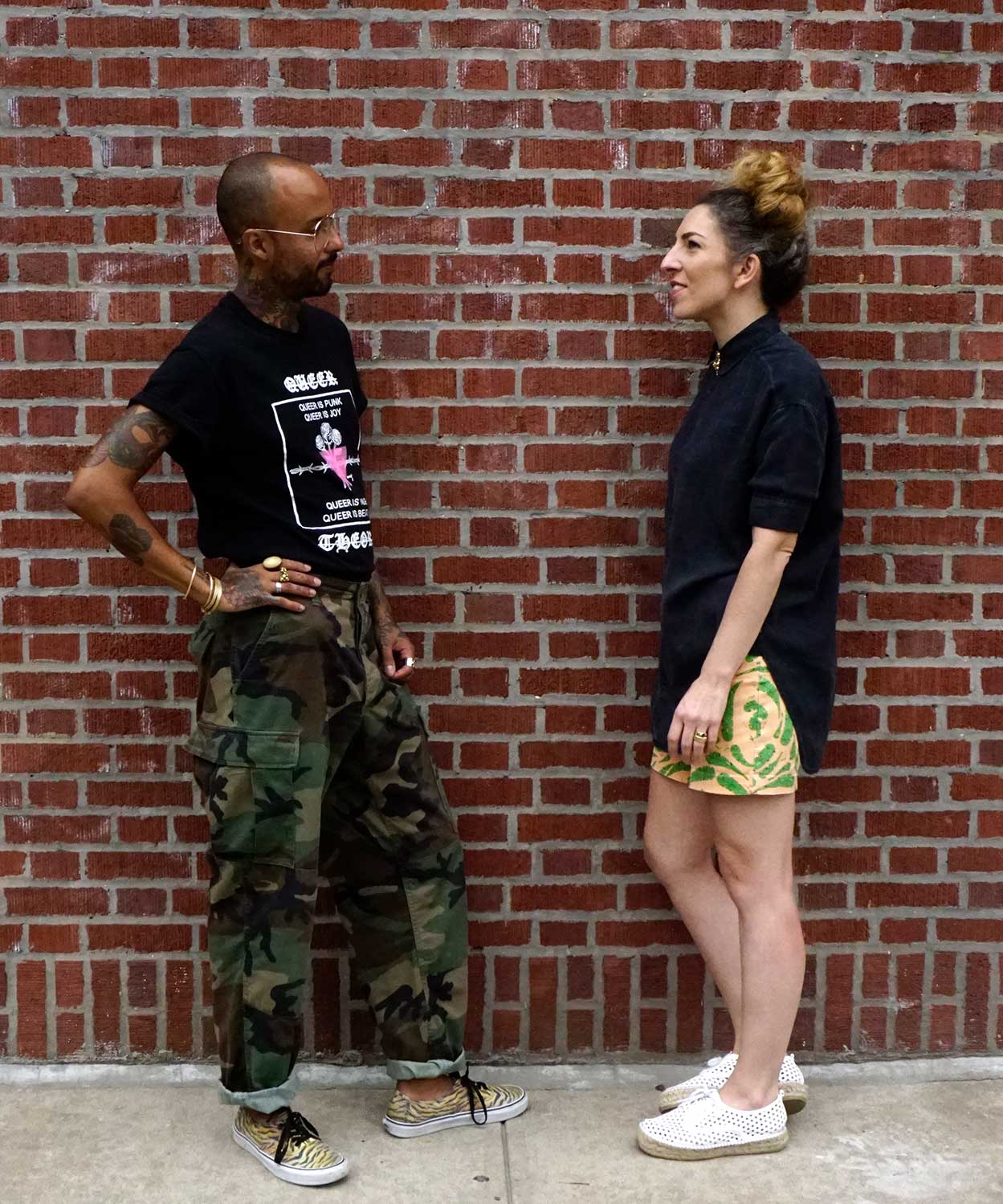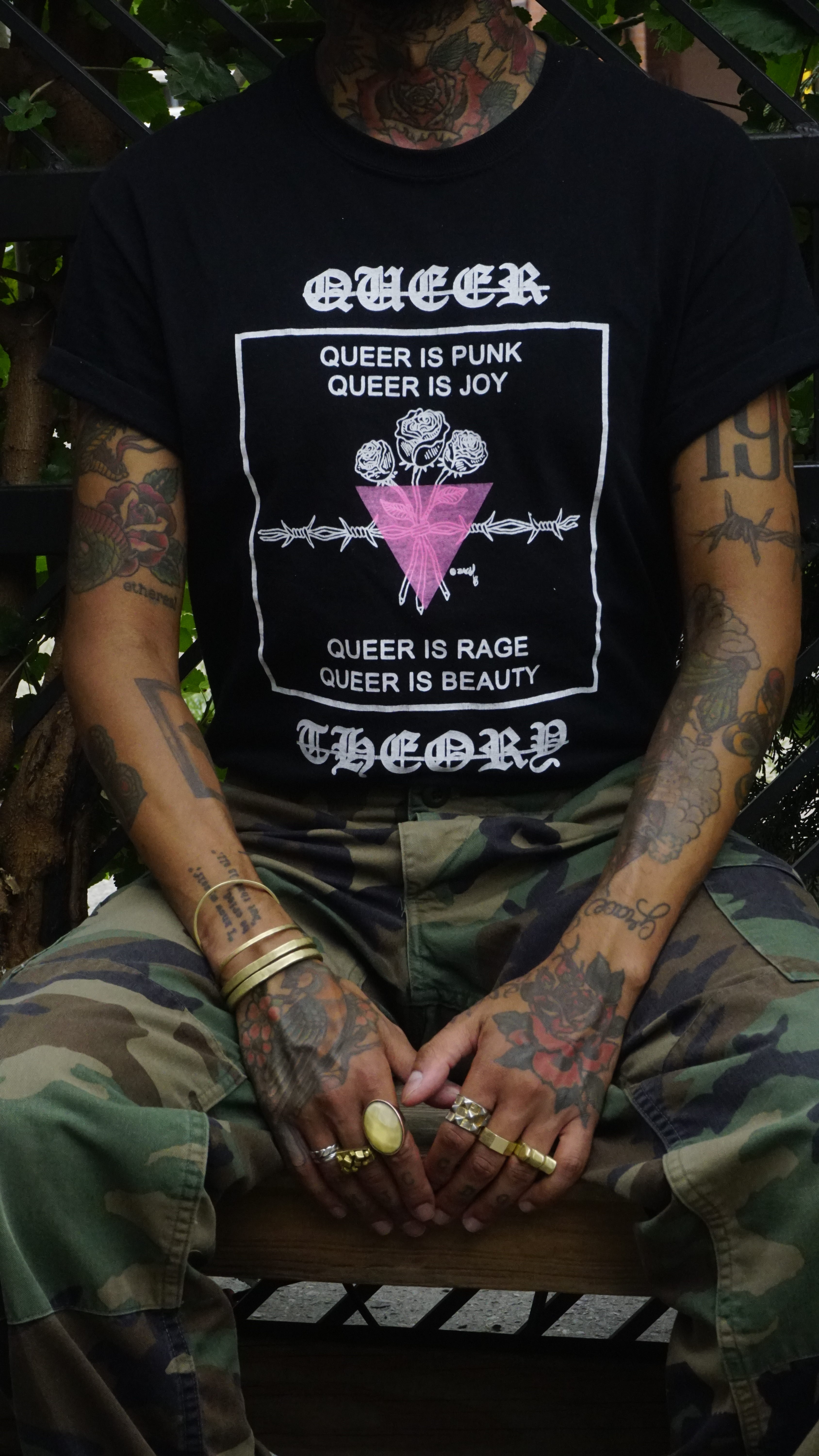Zach Grear was born and raised in San Francisco, but is now considered a Brooklyn local. He’s a queer designer with a defined punk-meets-erotica style and illustrates prints as well as shirts. We had a chance to catch up recently at the West Cafe in Williamsburg where we discussed the originality of punk, using art to support the AIDS and homeless community and more.

Q: Tell us about what’s on your mind right now with your work.
Zach: I like the idea of ownership of queer identity, or any identity. If you’re a person of color or anything at all. It’s hard to word it but, an aggressive ownership of it. When I say queer as punk it’s kind of like…I think the concept of punk belonging to more marginalized groups. If you Google punk it’s going to be a bunch of straight white men. It’s kind of what that aesthetic is and that’s fair but if you’re trying to reclaim what that idea is – it’s women and it’s women of color and it’s trans and it’s queer and it’s everything that’s outside of the patriarchy and so I guess that’s sort of what I want to tap into. That’s kind of where my mind is.
Q: It’s the originality of punk, is that what resonates?
Zach: Yes, to me it’s kind of that audacity to exist. Because there’s no pleasing society, so that’s the whole game. Here’s this standard of beauty, look like that. Loving yourself, that is the biggest act of rebellion, really.
Q: What was it like for you growing up in San Francisco?
Zach: Growing up in San Francisco was bewildering. There is just so much stimuli crammed into such a small space. I’m grateful to have been surrounded by so much beauty and artwork, especially as a queer person-of-color. It certainly shaped my instinctual search for beauty in whatever environment I’m in. However I also grew up surrounded by the AIDS devastation, the homelessness, the mental illness, the victims of which were all literally left on the street to fend for themselves just as the first tech wave hit. Growing up San Francisco just felt fast and wildly “other”.
Q: When did you move to New York? What would you say each city has taught you, shaped you as an artist?
Zach: In 2010, I was 24 when I realized how “other” San Francisco was. That was also when I was fascinated by New York City and the vastness of it. I just knew there was lot there and I wanted to be surrounded by it. If the city has taught me anything it’s the importance of focus. New York has a way of making you feel important because of the parties you go to or the outfits you wear…and that’s a nice feeling for maybe a week. I wanted more out of NYC, developmentally. Pulling away and focusing on my creativity—regardless of outside validation—has been the best lesson, and so far the most rewarding.

Q: Do you remember when you first started expressing yourself through art and what you created?
Zach: I’ve been drawing since the womb. I used to draw women with fancy dresses, lots of video game characters. It’s when I started creating my own characters, and then taking it one step further and writing stories about them, that I think I actually expressed a part of me.
Q: What gave you the idea to put some of your drawings onto shirts?
Zach: I wanted to make a zine but then I decided to make a shirt, I worked in retail at the time and I liked the idea of original t-shirts rather than mass produced t-shirt.
Q: How did you come to own your own brand and design clothes?
Zach: I put out some t-shirts on my Instagram, a pretty limited quantity and got a nice reaction. The more I do it the more addicting it is to come up with cool designs that might reach a queer audience across the world.
Q: How did the opportunity arise to create the AIDS Memorial shirt and donate a portion of the proceeds to Housing Works?
Zach: I had been following the AIDS Memorial project on Instagram for over a year when last October, Stuart the founder saw I was designing shirts and reached out to me about the collaboration. I designed artwork around the logo. Then Adam from Adamsnest.com was interested in making and selling the tees. (Adam’s Nest is a politically engaged, socially conscious online and physical retailer)
We all chose to donate $10 of every $30 shirt to the Housing Works (an organization to end the dual crises of homelessness and AIDS) because it made a lot to sense to do it. We launched in February, and have since shipped to 18 countries, sold roughly 750 shirts and raised about $5.1K for Housing Works. It ended up being a really amazing opportunity and I’m really happy with how it’s taken off, I’m really grateful.
Q: How did you come up with Boy Division and Grrrrl Division – what’s the relation to Joy Division?
Zach: BOY DIVISION just came into my head as a cute idea to blend a punk/post-punk aura with gay erotica. As I worked on that I knew I wanted to expand to incorporate more of a queer aspect, hence GRRRL DIVISION.
Q: Where do you get your inspiration for the tattoos in your drawings on your shirts?
It’s both. Some of the tattoos are words, numbers or songs that resonate with me, and some are inspired by real traditional style tattoos like roses or barbwire. I’m not trained in drawing tattoos so I’m learning as I go which has been really fun. And then depending on who I’m drawing I like to input aspects of their life. Like if I’m doing James Baldwin or Angela Davis, people I really admire, I input my favorite book titles from them or the year they were born to personalize it.
Q: Do you have any mantras or phrases you say to yourself along your creation process? When do you use them?
Zach: What keeps coming into my head is “it’s now or never”. As a creative, you have to be so much more aware of time. This life is finite, we have an expiration date, and there is literally no perfect time to finally start the “project you’ve been thinking about”. Do it now.
Q: What brands or people should we follow on Instagram right now and why?
Zach: I have so many favorite IG accounts/artists:
- Tamara Santibanez (@tamarasantibanez) → NYC Tattoo/artist
- Ruben Marquez (@broobs.psd) → SF Gay Mexican collage artist
- James Falciano (@jamesfalciano) → NYC Queer artist
- Grace Allison Perkins (@what_up_g_perks) → Self-declared salty queer
- Bound Leather Zine (@boundleatherzine) → Brooklyn based leathers zine
- Gabriella (@ggggrimes) → NYC nonbinary artist
Q: What do you hope to achieve with the brand?
Zach: What I hope to achieve with my art is to continue seeking my identity. Comparison culture is practically hand-fed to all of us daily, and as creatives I think cleaving out whatever shred of individuality we can is vital.
Q: How do you define success for yourself?
Zach: Success to me is the continued thrill of pursuing what I want to do creatively. Success is lifting other artists up while on that pursuit.
Q: What do you think of a website that features only brands created by people of color, women and/or the LGBTQ community?
Zach: I’m excited at a website showcasing only brands by POC, women, and the queer community. Looking out for each other is a pillar of oppressed communities. Joining as creatives is a powerful way to show our art, our lives, and our commitment to community.
If you enjoyed hearing the origin story of Zach Grear, drop your email on the line to learn about other brands run by people of color, women and LGBTQ.